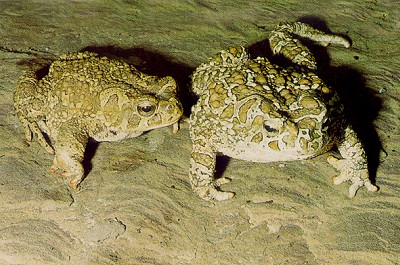| Bufo mauritanicus (Mauritanian Toad): Summary: A Report in DATZ 12/1999, page 30-33, by Alexander Pieh and Siegfried Walter
In 1999 in DATZ 12, page 30-33 contained a report by Alexander Pieh and Siegfried Walter
about a breeding success of Bufo mauritanicus. Here is a summary of their report.
Keeping: Throughout the whole year, except winter, the toads were kept in a humid warm green house measuring 3x4 m. Furnishing of the green house: clay substrate, a shower basin filled with water and planting buckets, jar fragments and flower pots for hiding. The toads diet consisted of locusts, zophobas, big earthworms and other insects, all dusted with vitamins and minerals.
Breeding: The toads were given a 3 months long winter dormancy in a frost-free cellar since 1993. Inspite of the stimulating natural differences of temperature, humidity and lighting conditions as well as the large water container no breeding took place until April 1998. In April 1998 when climate was warm the toads were placed in a bath tub outside, which was filled with water as high as 15 cm. As a precaution the bath tub was covered. Suddenly the male started amplexus and the female laid all her eggs during one single night. A few days later the tadpoles hatched. After leaving the egg shells the tadpoles were colored grey to black. During further development their dorsal side got brownish with grey and golden spots. At an age of approx. 2 weeks the tadpoles started to additionally breath air and their dorsal view no longer was oval but nearly pentagon shaped. The tadpoles were moved to a several bowls and tubs. Regarding water condition the tadpoles turned out to be quite adaptable and rearing them did not make problems. Necessary for good development seem to be water temperatures above 16°C. The tadpoles were fed with food for pet fish, algae, brewed salad and snatches of sweet water fish. The tadpoles were very shy and fled under furnishings when disturbed. This changed with metamorphosis. Approx. 6 weeks after hatching metamorphosis of the best developped tadpoles took place. At this point of time total size of the tadpoles was approx. 2,5-3,0 cm. After metamorphosis the young toads measured approx. 1 cm and had a redbrown spotted coloration with little orange warts, which especially occured along the lateral sides and parotoides. The legs showed a pattern of dark rings. Anyway, coloration of the juveniles was much less attractive as that of the adults. Many of the toadlets were further reared in a run outside, others were kept inside. The little toads turned out to prefer warm places. Only 1 day after leaving the water the young started eating vitamin dusted drosophila and springtails, later on also aphids, pillbugs and small crickets. Cannibalism between later metamorphosed toadlets and older ones only was observed in one single case which probably was an accident. Remarkable was that the young toads were not timid against one another. Adult Mauritanian Toads are shy against one another, except during breeding season. The author's conclusion: The authors believe that the following points were important for the breeding success: - nearly year round keeping in the green house (natural stimulation) - adequate sized area (green house 3x4 m) - good nutritional condition of the toads - regular winter dormancy (inspite of only known from certain populations in the wild) - adequate sized water - perhaps also low pressure area in spring 1998 The author's toads originated from a breeding success of the Exotarium Frankfurt. There the toads also had a cold dormancy and breeding occured in early spring in a fish tank of 200x70 cm at a water level of 12-15 cm. |
||

